Journey Through the Kii Peninsula: Where Timeless Nature Meets Ancient History
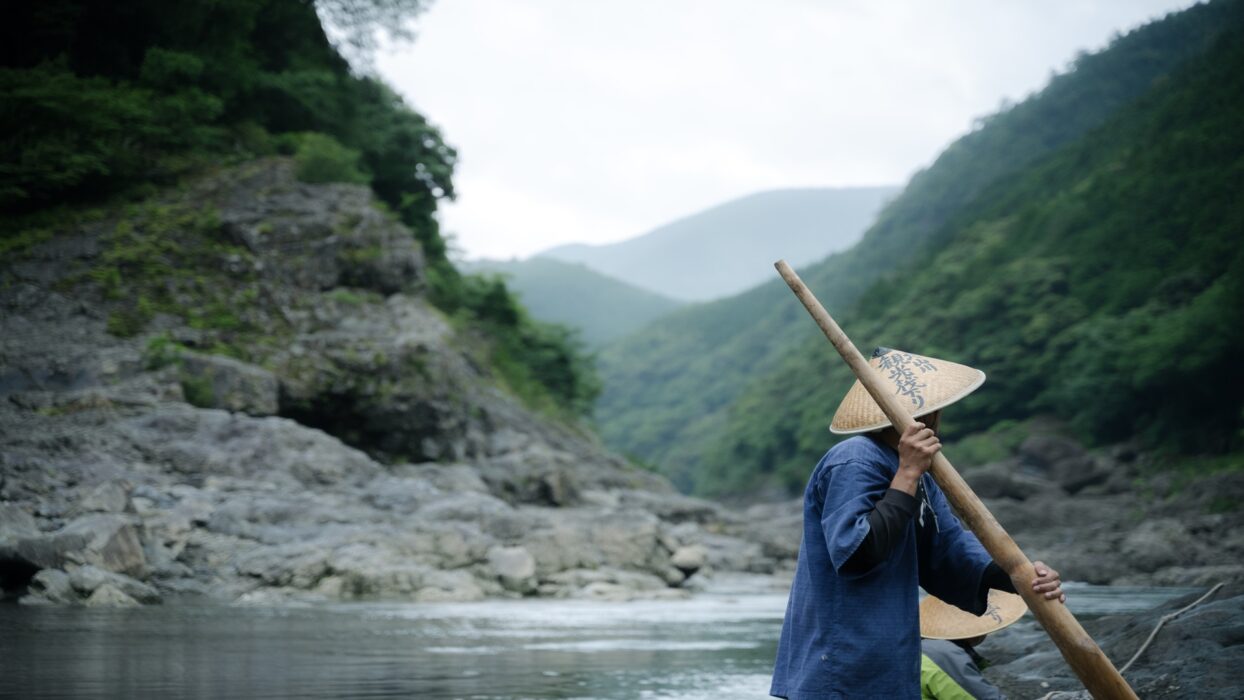
Nestled in the southern part of Mie Prefecture lies Yoshino-Kumano National Park, a sprawling natural wonder that encompasses mountains, rivers, and coastlines. Known for its diverse landscapes, the park includes the Osugidani Valley in the north, recognized as one of Japan’s three most beautiful valleys and a designated UNESCO Biosphere Reserve. Within its boundaries, the Kumano Kodo Iseji and parts of the Kumano River are jointly registered as the UNESCO World Heritage Site “Sacred Sites and Pilgrimage Routes in the Kii Mountain Range.”
This area, steeped in both deep natural beauty and rich historical significance, invites visitors to connect with the spiritual essence of nature that has been revered by the people of Japan for centuries.
- From Ise Shrine to the Sacred Grounds of Kumano Sanzan via the Kumano Kodo Iseji
・Kumano Hongu Taisha
・Oyunohara
・Kumano Hayatama Taisha
・Kamikura Shrine
・Kumano Nachi Taisha
・Hiro Shrine - Walking the Path of Prayer: The Iseji Route of the Kumano Kodo
- The Sculpted Beauty of Nature: Onigajo’s Demonic Rock Formations
- Japan’s Oldest Shrine and Its Towering Rock Deity
- Kumano River: Touring the Only River World Heritage Site on a Traditional Sandanpo Wooden Boat
- Water Activities to Experience the Traditional Boating Skills of Raftsmen Who Transported Timber to Shingu
- Hiking the Emerald Lakes of Osugidani, a Hidden Paradise
- Access to Mie Prefecture
From Ise Shrine to the Sacred Grounds of Kumano Sanzan via the Kumano Kodo Iseji
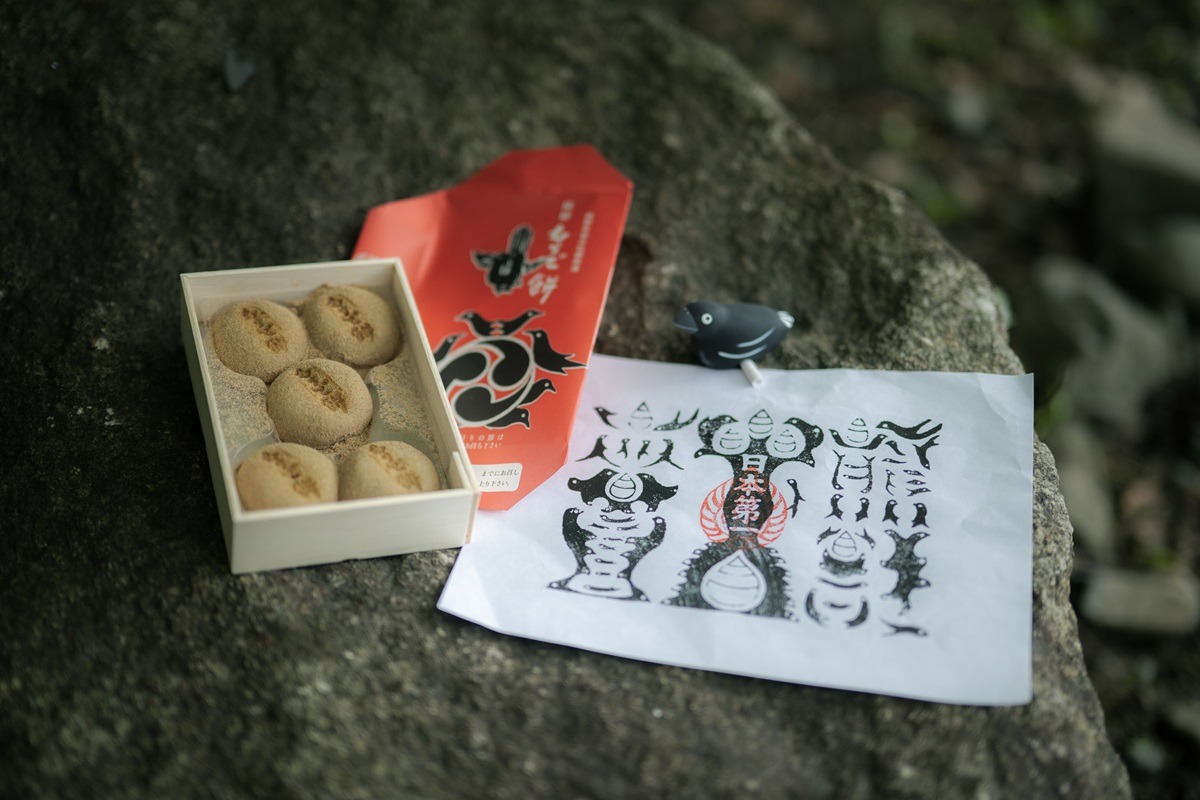
Approximately 14 million years ago, a massive volcanic eruption occurred in the Kumano region, one of the largest in Earth’s history. The magma that cooled and solidified eventually transformed into igneous rock, giving rise to the dynamic landscape of the Kumano area. This process created majestic rock formations and waterfalls like Hananoiwaya and Nachi Waterfall. The people of the time looked up at these natural marvels and felt the presence of deities within them, giving birth to the Kumano faith.
By the late Heian period (after 794), a unique belief system emerged, combining Buddhism, introduced from the continent, with ancient Japanese spiritual practices such as Shugendo. This syncretic faith held that deities could manifest as Buddhas, appearing in forms to save all living beings. The core of this belief was centered around the three shrines—Kumano Hongu Taisha, Kumano Hayatama Taisha, and Kumano Nachi Taisha—each rooted in its own ancient nature worship.
Together, these three shrines, united by enshrining each other’s principal deities, came to be known collectively as the Kumano Sanzan. It was believed that visiting Kumano Hongu Taisha would grant salvation in the afterlife, Kumano Hayatama Taisha would purify the sins of past lives, and Kumano Nachi Taisha would bless relationships in the present life. As such, a pilgrimage to these three shrines was thought to ensure peace and prosperity across past, present, and future. Over time, Kumano gained a reputation as a sacred site embodying the Pure Land philosophy, drawing countless pilgrims to its hallowed grounds.
In July 2004, the sacred sites and pilgrimage routes of the Kii Mountain Range, including the Kumano Sanzan, were inscribed as a UNESCO World Cultural Heritage Site. This recognition highlights the deep connection between the lush nature of the Kii Mountains, its regenerative power, and the rich cultural heritage of faith developed by the people who lived there.
Kumano Hongu Taisha
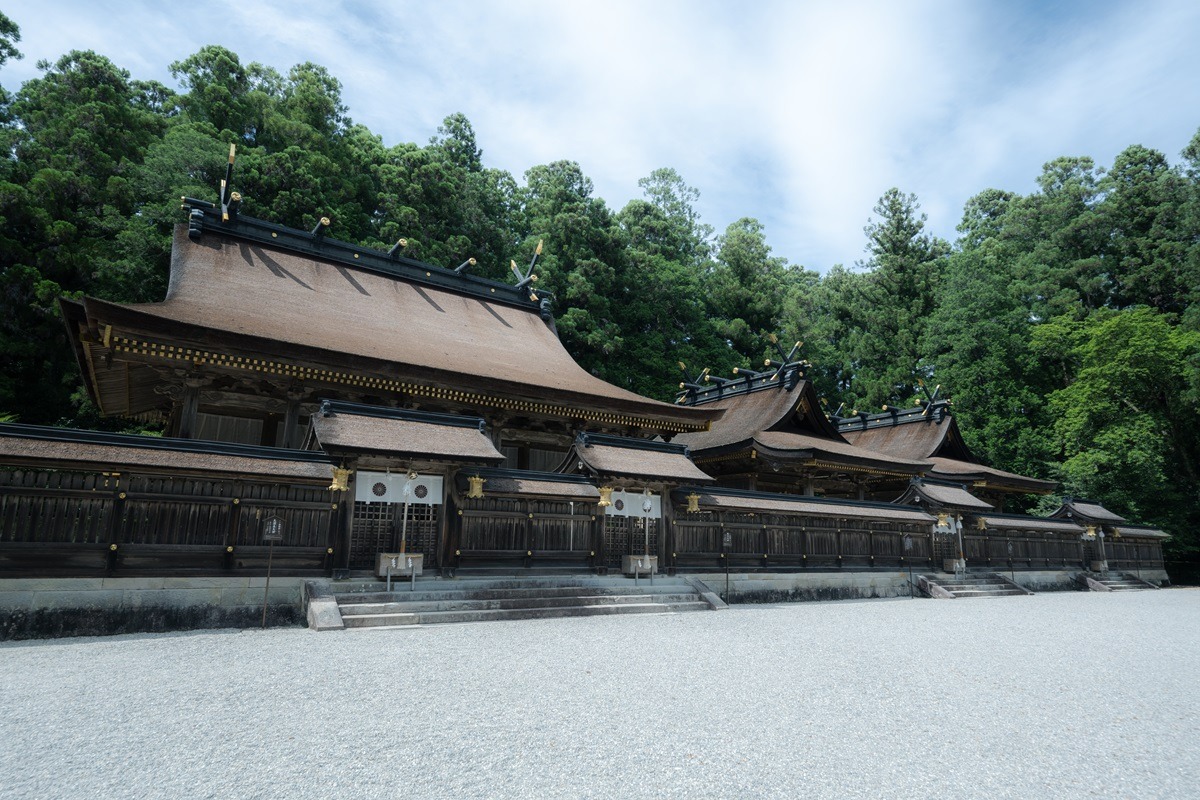
Kumano Hongu Taisha serves as both the starting and ending point of the Kumano Kodo pilgrimage route. The main shrine enshrines four deities, with a prescribed order for worship.
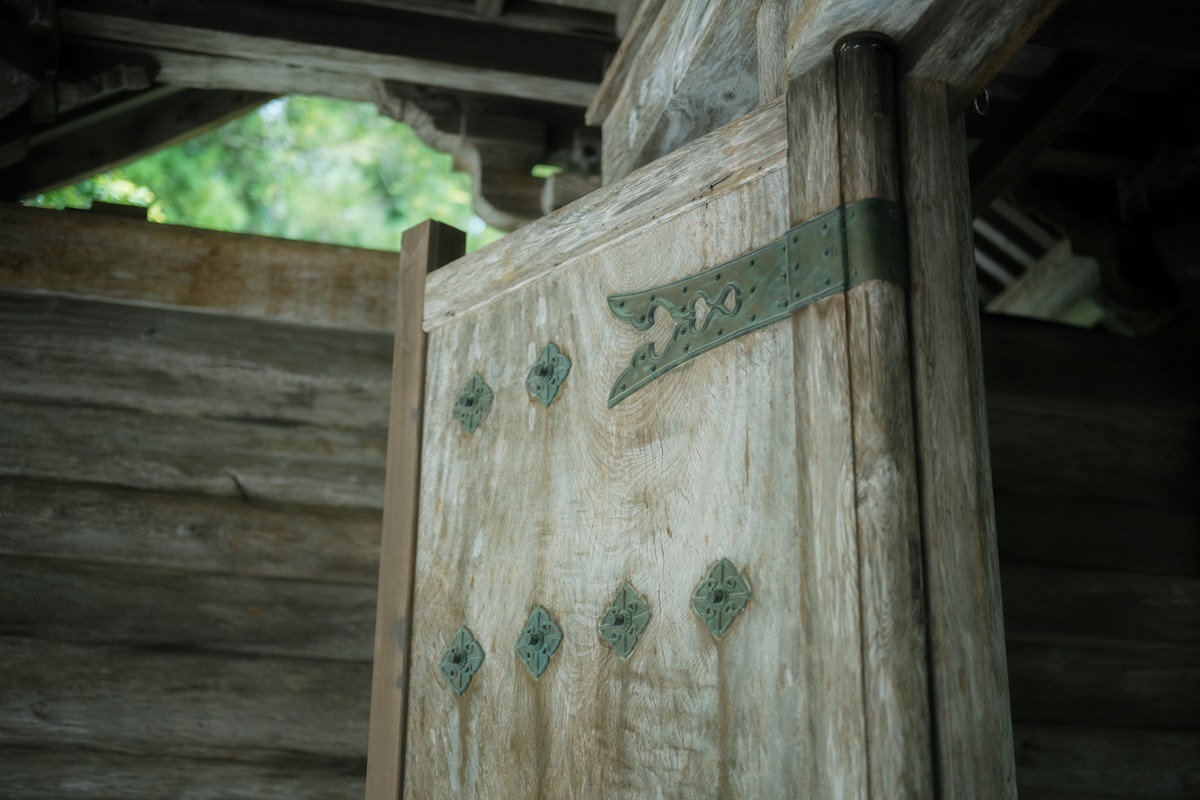
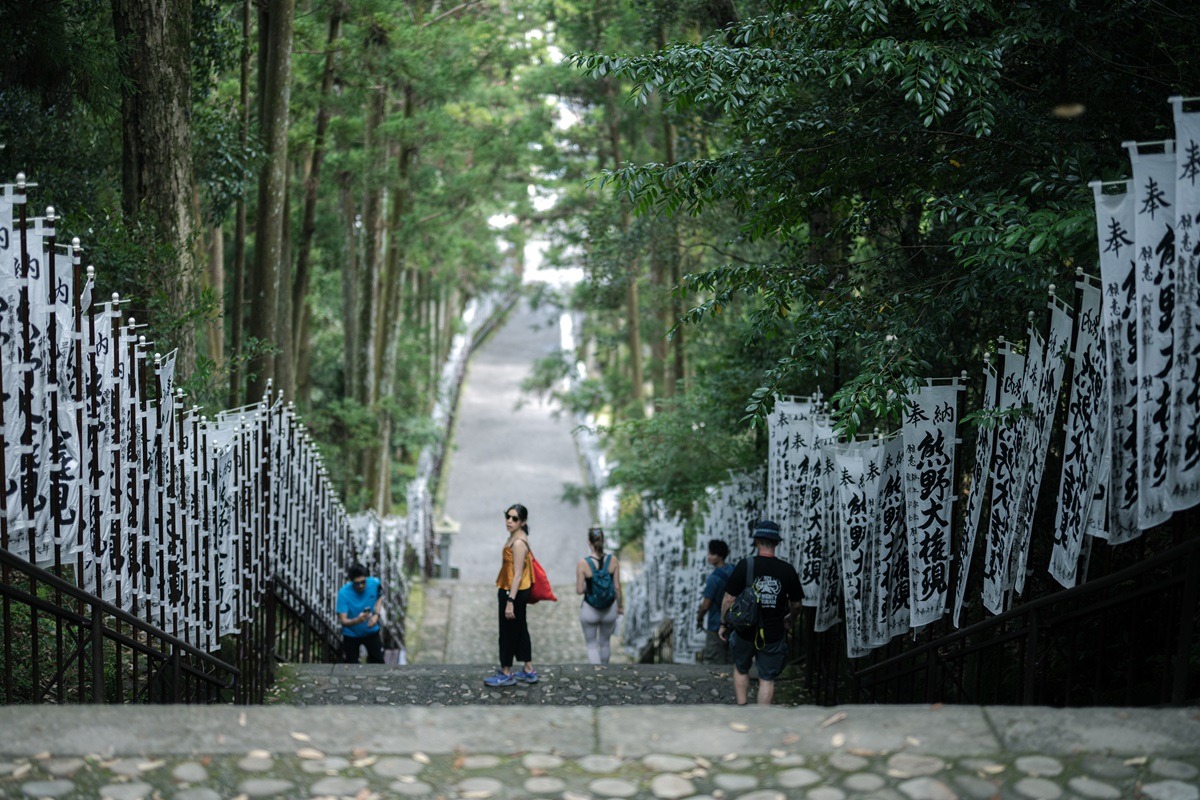
Oyunohara

A five-minute walk from the main shrine of Kumano Hongu Taisha leads to Oyunohara, where a towering torii gate stands proudly in the middle of beautiful rice paddies. Measuring approximately 34 meters in height and 42 meters in width, it is the largest in Japan. This location, once the confluence of the Kumano River and its tributaries, Otonashi and Iwata Rivers, was home to the Kumano Hongu Taisha until a great flood in 1889. Today, the site features stone shrines and a grove, and stepping through the torii gate evokes a profound sense of the divine presence.

Kumano Hongu Taisha
Address: 1110 Hongu, Hongu-cho, Tanabe-shi, Wakayama-ken
Tel.: 0735-42-0009
Visiting Hours: 8:00–17:00
Kumano Hayatama Taisha

Kumano Hayatama Taisha is renowned for its vibrant red shrine buildings
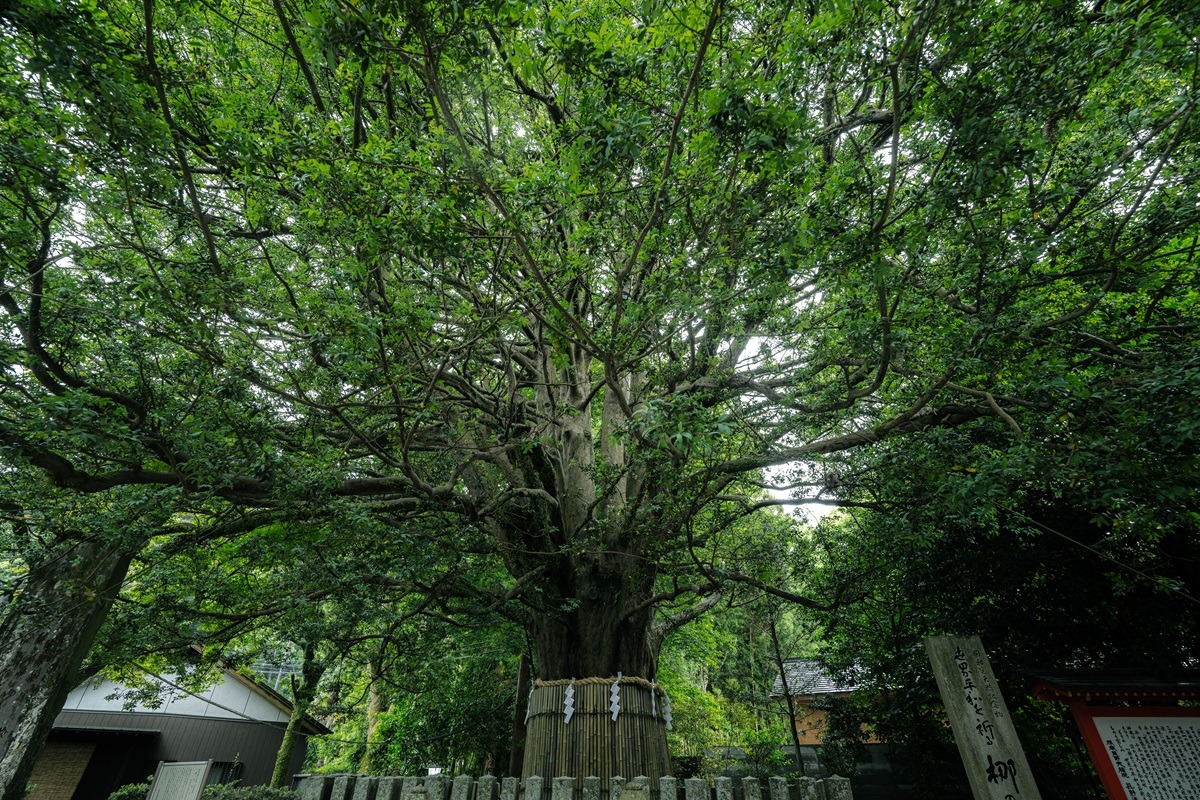

During the Sengoku to Edo periods (15th century onward), there were itinerant Buddhist nuns known as bikuni who traveled across Japan carrying pictures of the Kumano Ten-Worlds Mandala and Nachisan Shrine Mandala. These nuns used these illustrated scrolls to preach about the cycles of life and death, the afterlife, and salvation, drawing on the depictions of the heavens, hells, hungry ghosts, and other realms.
Kamikura Shrine
As a subsidiary shrine of Kumano Hayatama Taisha, Kamikura Shrine is perched on a massive boulder known as Amanoiwa-tate, mentioned in one of Japan’s oldest historical texts, the Nihon Shoki. This sacred site is believed to be where the Kumano deities first descended to earth. Situated on a steep cliff at an elevation of 100 meters on Mount Kamikura, the current location of Kumano Hayatama Taisha is said to be called “Shingu” from the relocation of this shrine.

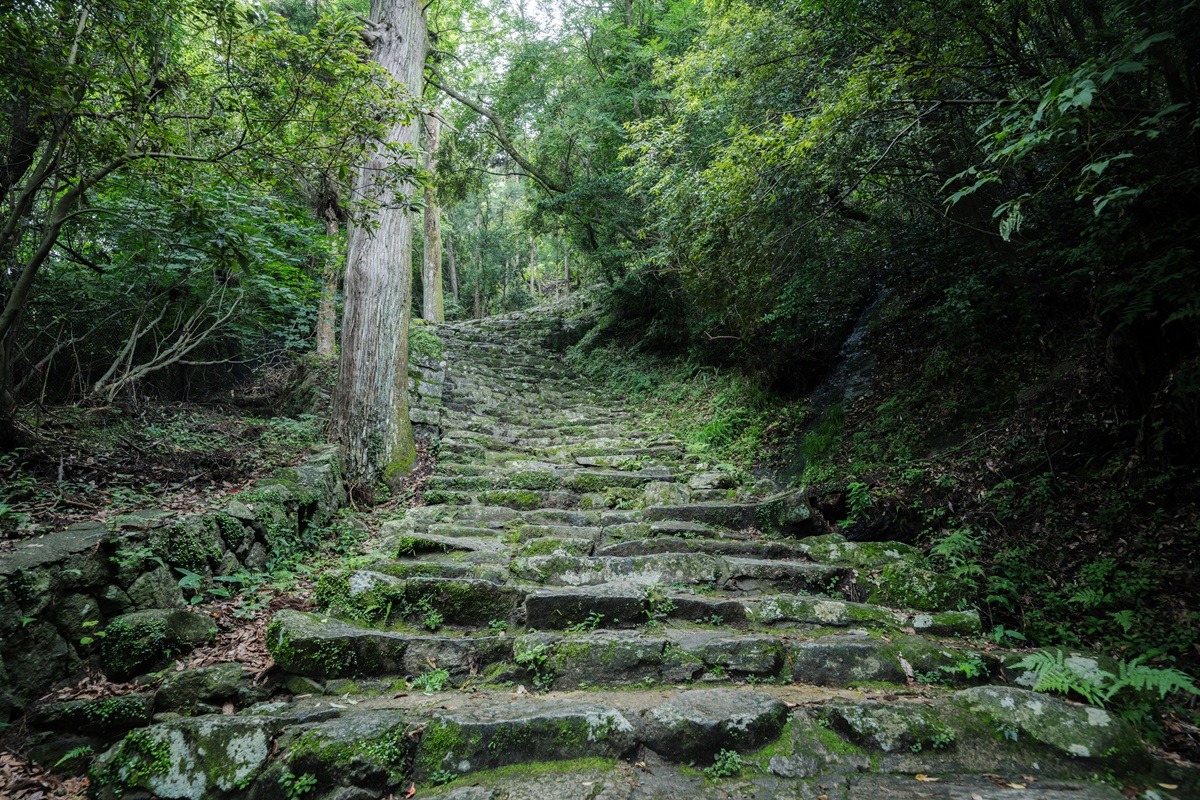

Kumano Hayatama Taisha
Address: 1 Shingu, Shingu-shi, Wakayama-ken
Tel.: 0735-22-2533
Visiting Hours: Sunrise to 17:00
Kumano Nachi Taisha

Kumano Nachi Taisha stands on the mountainside of Nachisan, or Mount Nachi, the final destination of the Kumano pilgrimage, accessible after ascending 473 stone steps. The shrine, with its vermilion-lacquered hall that is said to preserve its ancient appearance better than the other Kumano Sanzan shrines, houses six shrine buildings in its inner sanctuary.
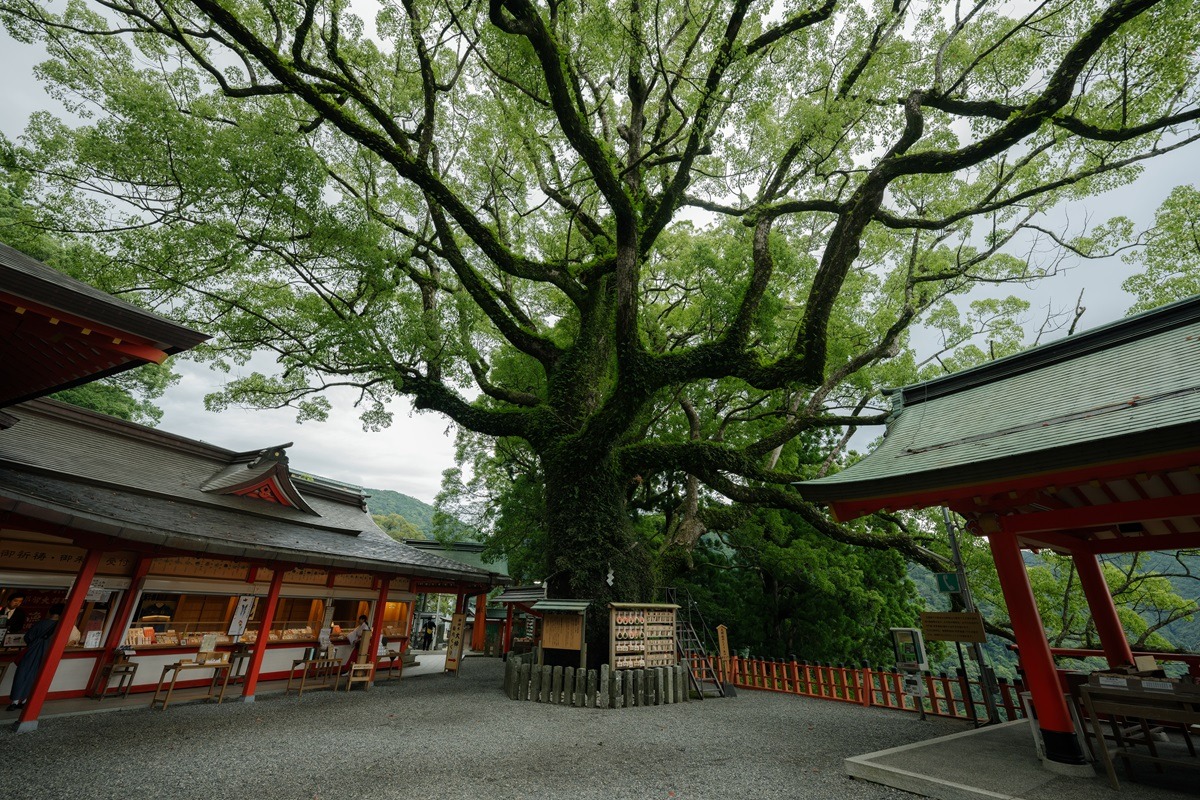

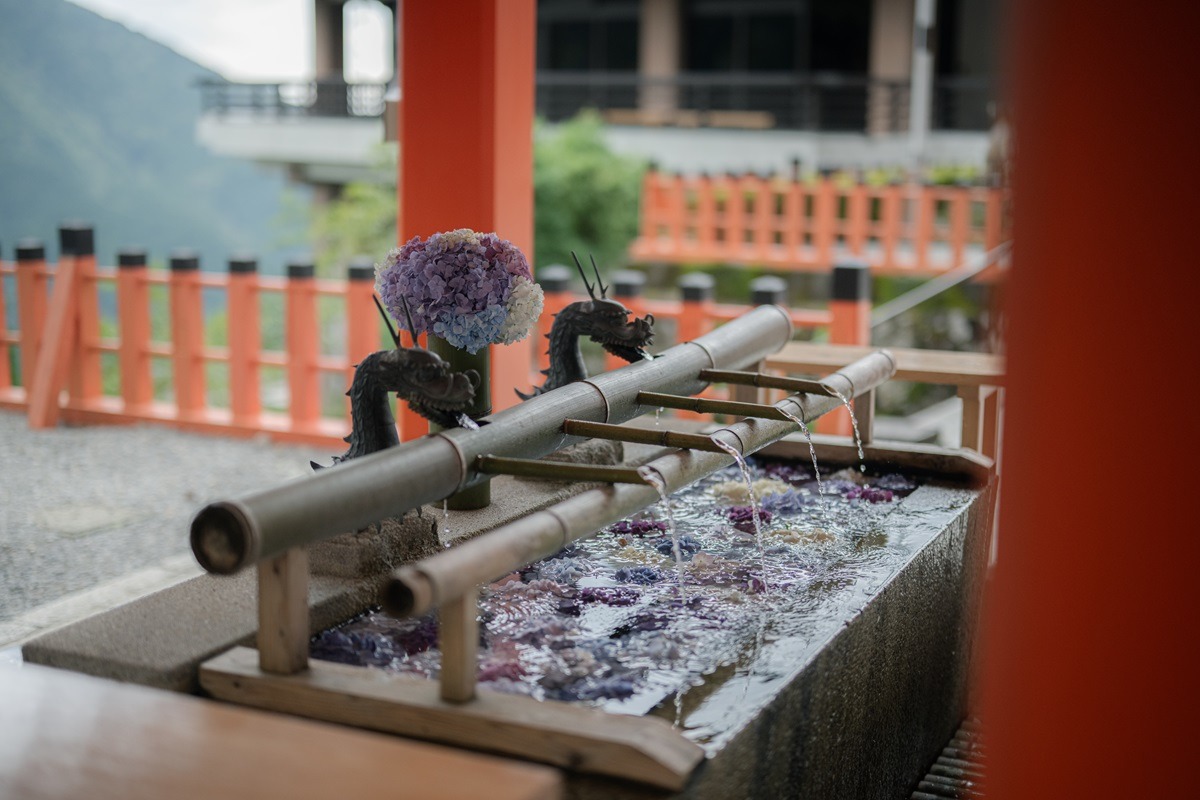
Hiro Shrine
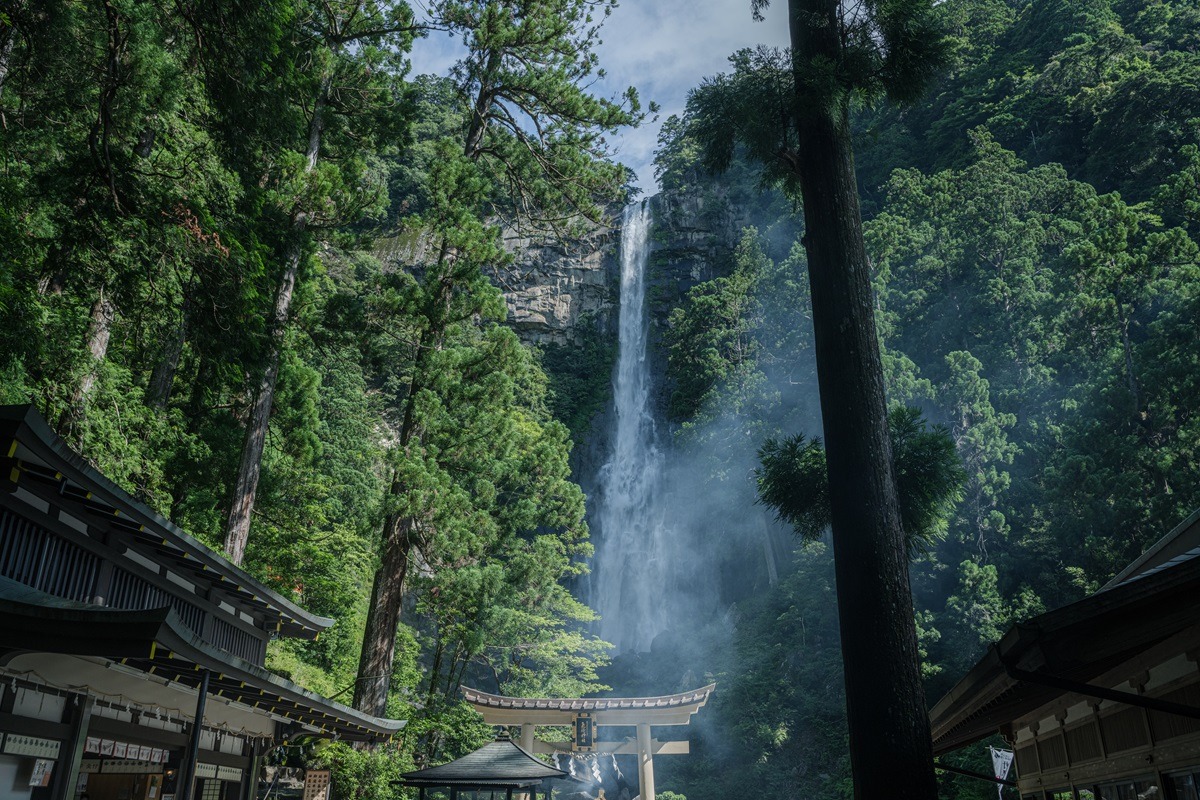
Hiro Shrine is a subsidiary shrine of Kumano Nachi Taisha. Without a shrine building, the shrine’s sacred object of worship is the Nachi Waterfall itself, which boasts the tallest drop in Japan at 133 meters. The sight of the waterfall, surrounded by primeval forest and thundering down the mountainside, is truly awe-inspiring.

In 2024, special events will be held at each of the three Kumano Sanzan shrines to commemorate the 20th anniversary of the Kumano and Koyasan sites’ registration as UNESCO World Heritage sites. Limited-edition special goshuin stamps will also be available.
Kumano Nachi Taisha
Address: 1 Nachisan, Nachikatsuura-cho, Higashimuro-gun, Wakayama-ken
Tel.: 0735-55-0321
Visiting Hours: 7:30–16:30
Walking the Path of Prayer: The Iseji Route of the Kumano Kodo

The network of pilgrimage routes leading to the three Kumano Sanzan shrines is collectively known as the Kumano Kodo.
The Kumano Kodo consists of six main routes, covering a total distance of about 1,000 kilometers. The Kiiji and Nakahechi routes, once walked by Heian-period aristocrats, are paths steeped in history, with remnants of old teahouses and stone Buddha statues. The Ohechi and Iseji routes offer breathtaking views of the Kumano Sea, extending from Shionomisaki Cape at the southern tip of Wakayama Prefecture to Daiozaki in Mie Prefecture. The Kohechi route, which traverses the towering 1,000-meter mountains, and the rugged Omine Okugake route, which crosses the challenging Omine Mountains, are for advanced hikers. Each of these routes offers stunning scenery, from sea and mountain vistas to unique rock formations, giant trees, and cultural heritage sites. The Kumano Kodo, linking the sacred sites of Kumano, Mount Koya, Ise, and Yoshino Omine, embodies the philosophy of coexistence and harmony.


The Iseji Route, connecting Ise Jingu, considered the spiritual heart of Japan, with the Kumano Sanzan shrines, is known as a “path of prayer.” Although this long route spans about 170 kilometers, the deep spiritual connection between the two sites is reflected in the old saying, “Seven times to Ise, three times to Kumano.” Despite the challenging journey, both destinations were places of deep admiration and longing.
The Kumano area is known for its frequent rain, but even in poor weather, the sight of the centuries-old stone paths glistening with rain and the lush greenery shedding jewel-like water droplets creates a magical atmosphere.
Kumano Kodo Iseji, Magose-toge Pass
Address: near Aiga, Kihokucho, Kitamuro-gun, Mie-ken
Tel.: 0597-89-6172 (Higashikishu Regional Organization)
The Sculpted Beauty of Nature: Onigajo’s Demonic Rock Formations

While most of the Kumano Kodo routes wend through forested mountains, the Iseji route is notable for its proximity to the sea. The breathtaking scenery of the Kumano Sea, especially along the eastern coast of Mie Prefecture, is a highlight of the journey. Among the many natural wonders is Onigajo, a World Heritage site featuring a series of bizarre rock formations, shaped by the relentless waves of the Kumano Sea.
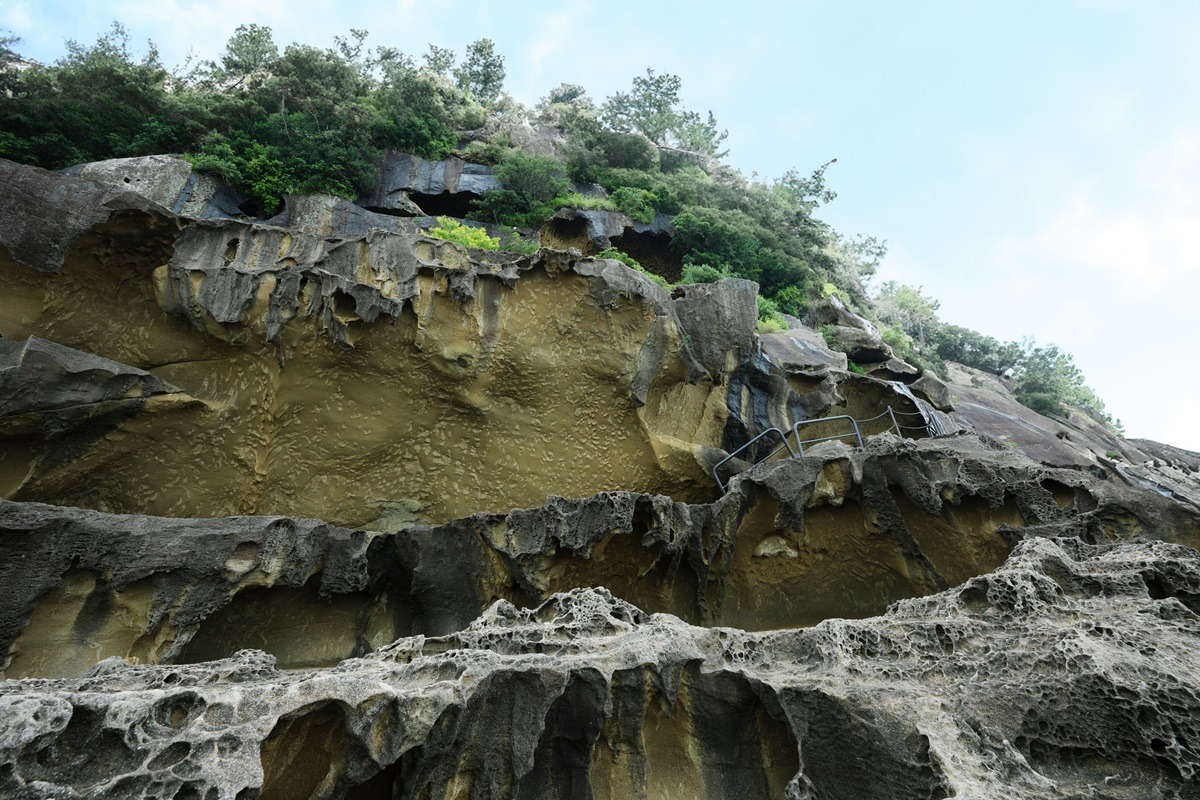
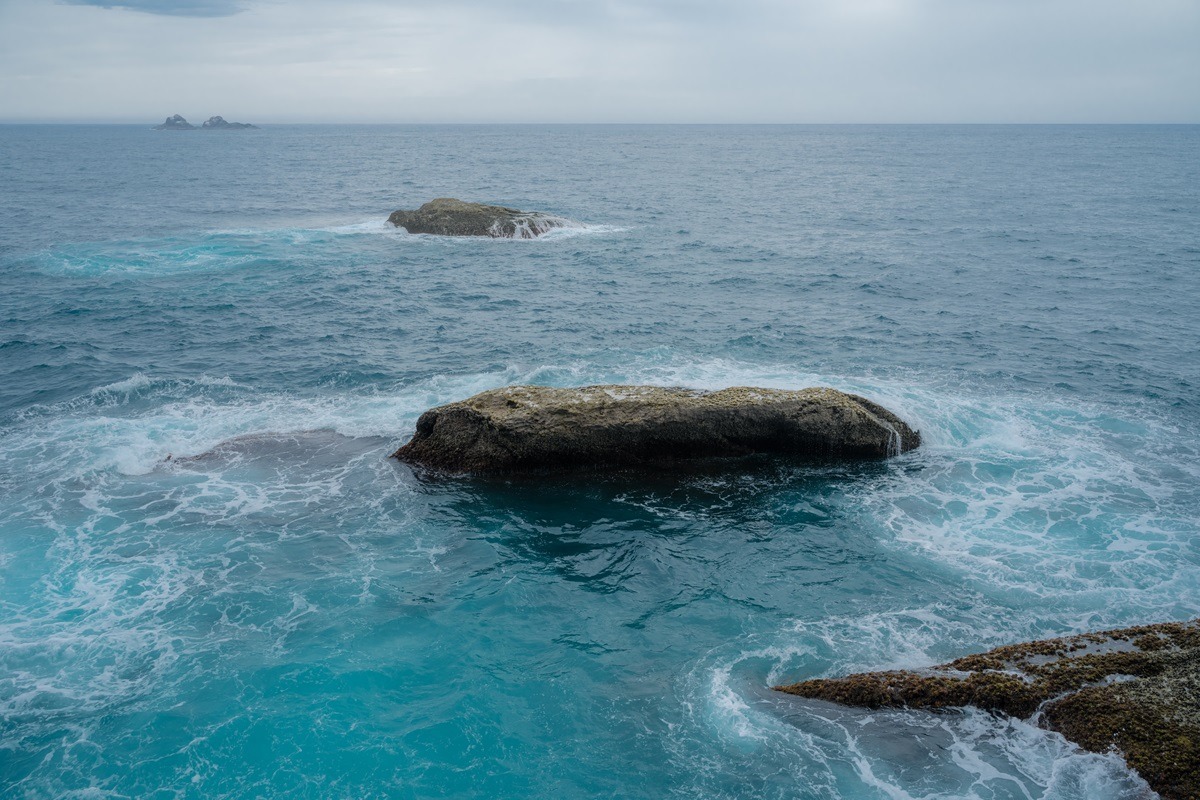
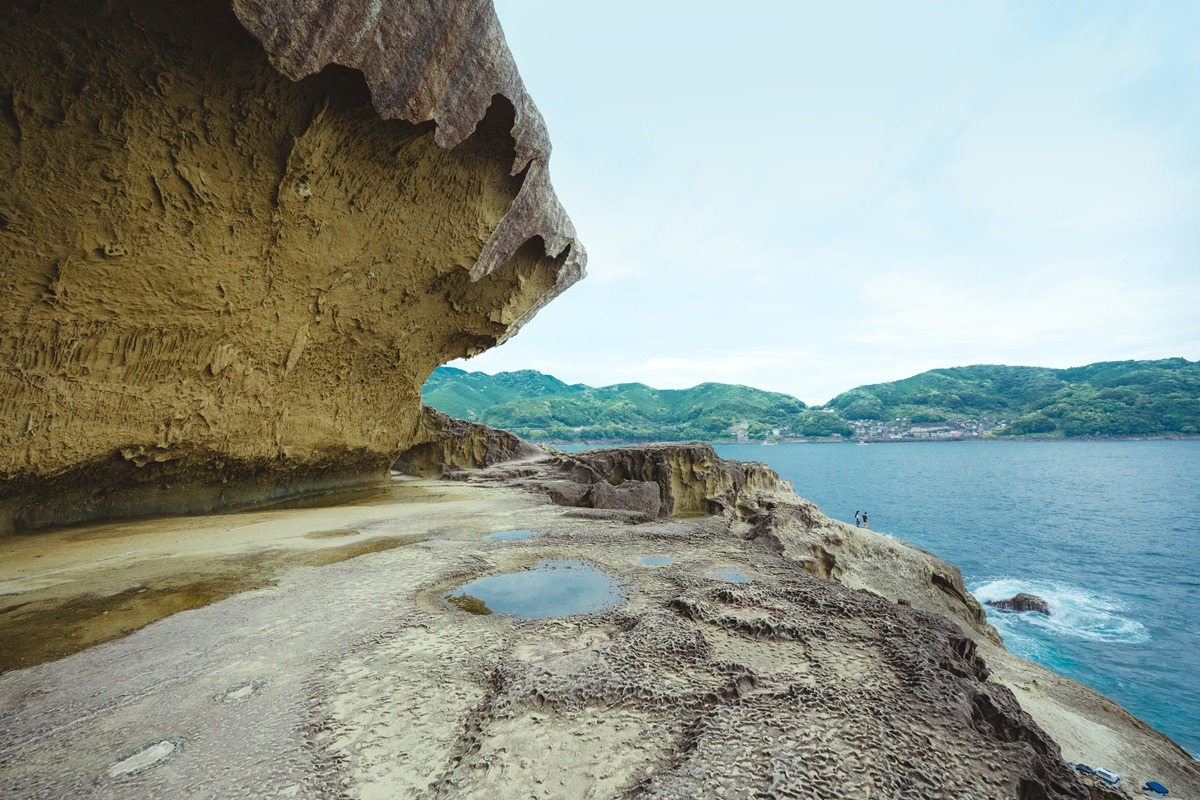
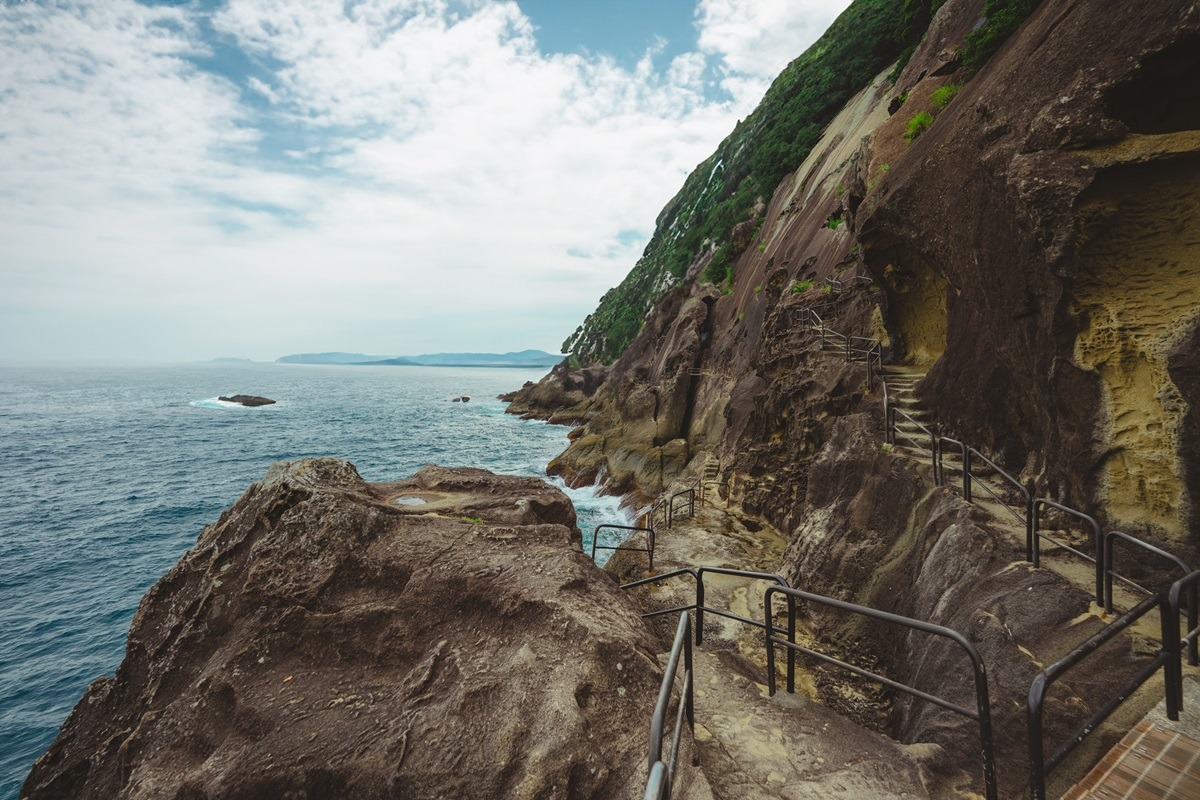
These massive tuff cliffs, sculpted by wave erosion and uplifted by several large earthquakes, extend for about a kilometer along a cliffside path, allowing visitors to experience the raw power of nature up close.

Onigajo marks the southernmost point of the ria coast that stretches from Ise-Shima, after which the landscape transitions into the gentle slope of Shichiri Mihama Beach.
Onigajo Center
Address: 1835-7, Kinomoto-cho, Kumano-shi, Mie-ken
Tel.: 0597-89-1502
Hours: 9:00–17:00 (weekdays, weekends, and holidays)
Closed: Open Year-Round
Japan’s Oldest Shrine and Its Towering Rock Deity

The Hananoiwaya Shrine, mentioned in Japan’s oldest historical text, the Nihon Shoki, as the site where the land of Japan was created, is a place of deep spiritual significance. Facing the Kumano Sea, the shrine’s sacred object of worship is a towering rock formation approximately 45 meters high. According to legend, this is the tomb of Izanami, the mother of the gods, who perished after giving birth to the fire god Kagutsuchi. As a site of ancient nature worship that predates the Kumano Sanzan faith, Hananoiwaya Shrine holds significant importance and is considered one of Japan’s spiritual origins, now recognized as a World Heritage site. The legendary Izanami is also mother to Amaterasu, the deity enshrined at Ise Jingu. It is strongly believed to be a place where the underworld and the living world connect, making it a popular “power spot” for visitors seeking spiritual renewal.



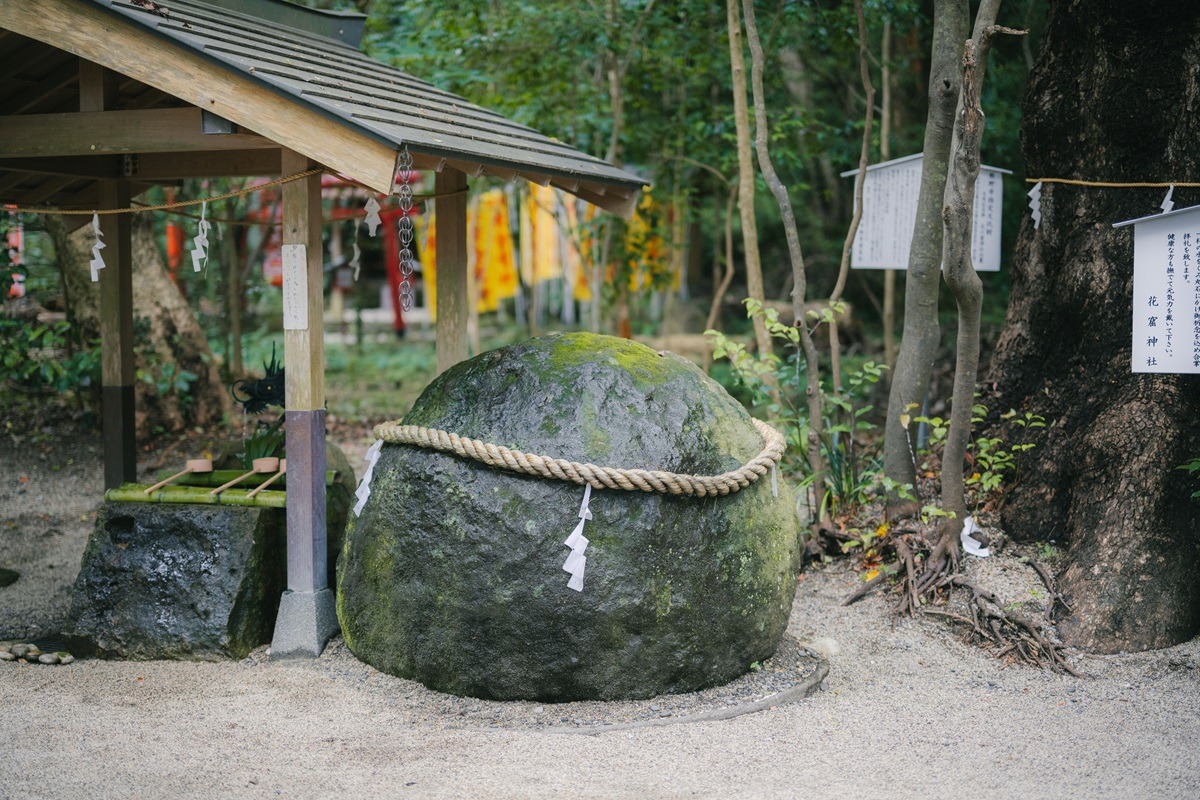

Hananoiwaya Shrine
Address: 130 Arima-cho, Kumano-shi, Mie-ken
Tel.: 0597-89-2881
Kumano River: Touring the Only River World Heritage Site on a Traditional Sandanpo Wooden Boat

There are only two cultural routes registered as World Heritage sites in the world. One is the Camino de Santiago pilgrimage route, which extends from France to Spain, and the other is Japan’s Kumano Kodo. A portion of the Kumano River included in the Kumano Kodo, making it the only river pilgrimage route in the world registered as a World Heritage site.

Yoshikazu Tanigami, the only boatbuilder in the town of Kiho at the southernmost tip of Mie Prefecture, constructs traditional Kumano River wooden boats known as sandanpo. These wind-propelled boats, distinguished by their sharply curved bows, measure 8.6 meters in length and about 1.6 meters wide, featuring three sails mounted on a 5-meter mast.
Until the 1960s, it was common for each household to own a boat for transportation and fishing, with river travel serving as the primary mode of transport. The Kumano River winds blow consistently from the mountains to the sea in the early mornings, reversing direction as the temperature rises around 10 a.m., allowing the sandanpo boats to harness the wind for propulsion.
While the tradition of riverboats dwindled with the advent of roads, Tanigami has revived it by offering river cruises, serving as a boatman on his handmade sandanpo boats.

The tour experience at the Kumano River Experience is a unique opportunity to learn about the history and lifestyle of the World Heritage area while enjoying the beautiful scenery of the Kumano River.
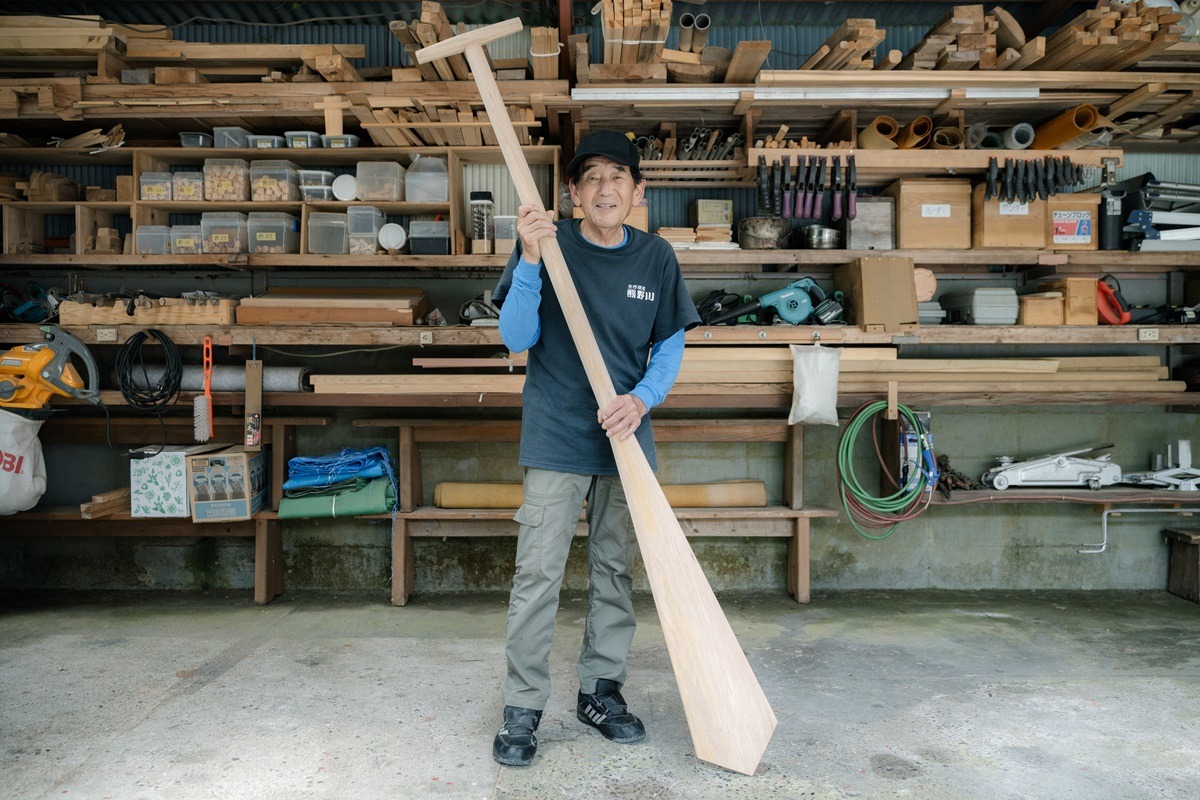
Kumano River Boat Tour
From March to mid-December (reservation required), approximately 2 hours, starting at 9,000 yen per person (4,500 yen per person for two people, and 3,500 yen per person for three or more people).
Kumano River Experience
Address: 203 Kitahizue, Kiho-cho, Minamimuro-gun, Mie-ken
Tel.: 0735-21-0314 (9:00–17:00)
Water Activities to Experience the Traditional Boating Skills of Raftsmen Who Transported Timber to Shingu

Shingu City, located on the border of Mie Prefecture, is home to Kumano Hayatama Taisha Shrine and was once a bustling hub for timber transport until the 1950s. Raftsmen from upstream villages such as Totsukawa and Kitayama would float timber down to Shingu. It was said that the wealthy timber merchants of the city would indulge in the entertainment districts after work, adding to the town’s lively atmosphere.
Kitayama Village is part of Wakayama Prefecture but is surrounded by Mie and Nara Prefectures, making it Japan’s only “enclave village.” The Kitayama River sightseeing raft ride is a water activity adapted from the 600-year-old tradition of rafting.
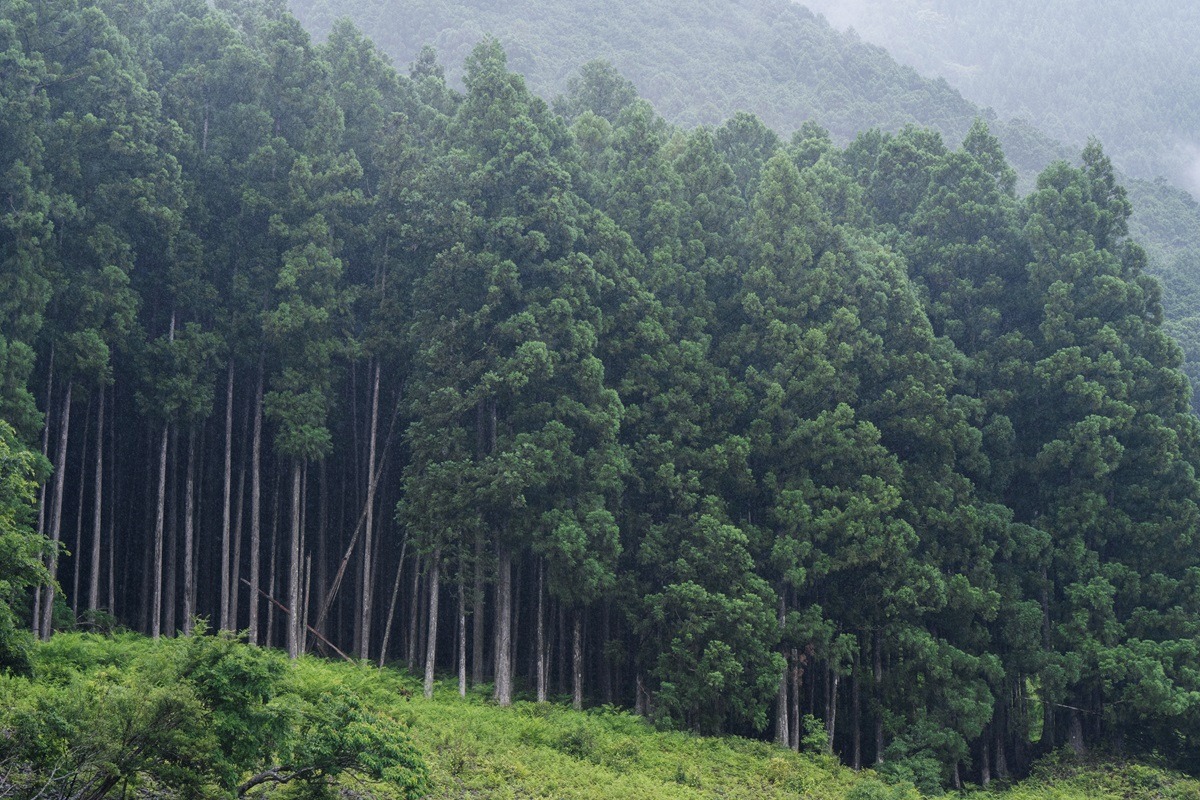

Raftsmen in the past often faced life-threatening dangers. Although the job was risky, it provided substantial income, making it a coveted profession among the villagers. On sightseeing rafts, one of the attractions is watching the raftsmen skillfully control the vessel with their oars. “The thrill of descending rapids with just an oar and without a safety rope is something you can hardly experience in today’s world,” said Makoto Banya. Each raft weighs approximately one ton per section, linked together seven times. A raft, made from cedar logs and about 30 meters long, is navigated down the river by three raftsmen who maintain balance. It takes at least three years of training to become a fully-fledged raftsman. The ability to safely transport passengers while considering the daily changes in water flow and wind is due to their solid, training-backed skills.



Sightseeing raft rides operate twice daily from May to the end of September. Web reservations are accepted up to three days in advance; after that, inquiries are only accepted by phone. Participants must be between 10 and 75 years old, in good health and physically fit. The fees are 6,600 yen for adults and 3,300 yen for elementary school students (2024 season rates; subject to change). The journey covers approximately 5.5 kilometers, passing through nine rapids points, and takes about 70 minutes.
In Kitayama Village, in addition to sightseeing rafts, various activities taking advantage of the natural beauty of Kitayama’s mountains and rivers are available, such as rafting and the “Raftsmen’s Path” trekking course.
Kitayama Village Tourism Center
Address: 335 Shimooi, Kitayama-mura, Higashimuro-gun, Wakayama-ken
Tel.: 0735-49-2324
Hours: 9:00–17:00
Hiking the Emerald Lakes of Osugidani, a Hidden Paradise

Osugidani, located in Yoshino-Kumano National Park, is one of Japan’s three great valleys and is often referred to as the hidden gem of the Kinki region. Selected as one of Japan’s 100 most secluded regions, the valley is fed by the crystal-clear waters of the Miyagawa River, which flows from Mount Odai to Ise. The hiking trail in Osugidani offers breathtaking views of seven waterfalls and eleven suspension bridges.


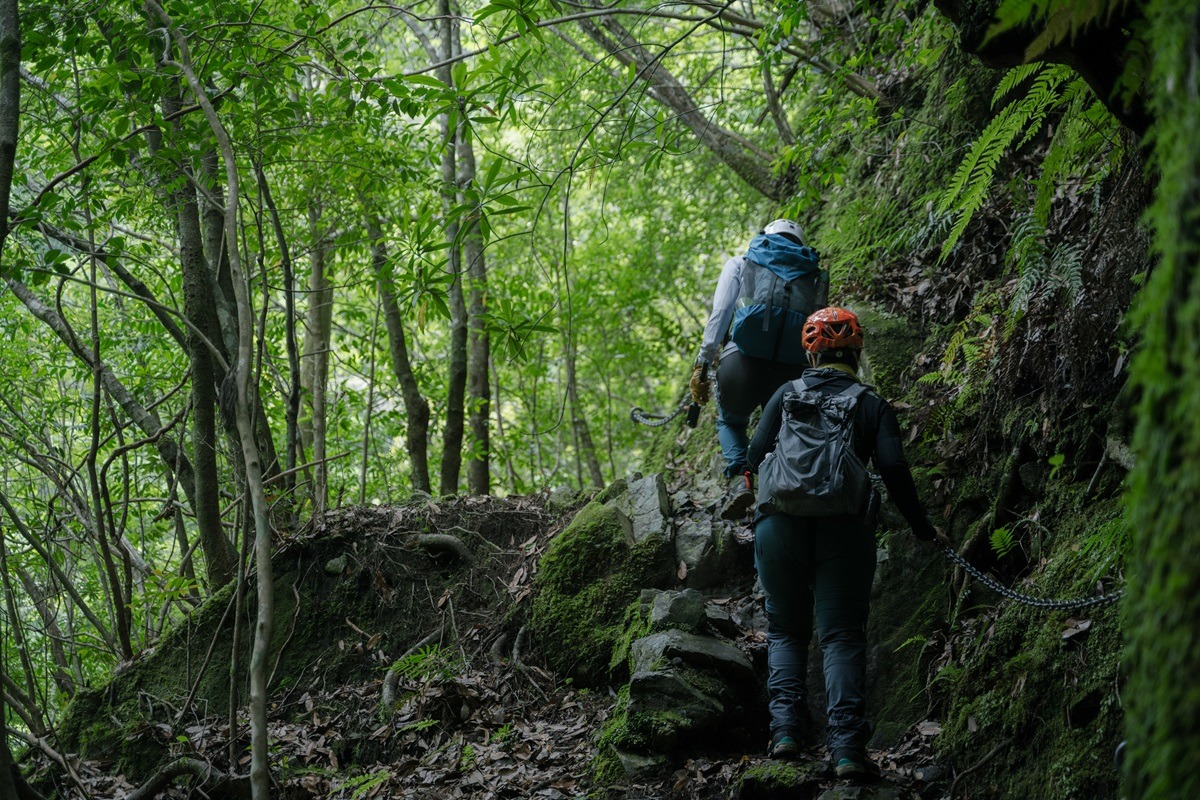


Verde Odai Tourism offers tours including day hikes for beginners (6,800 yen) and overnight mountain hut tours for intermediate hikers (38,000 yen), with private guides also available (33,000 yen per guide). In the Oku-Ise Dam Lake area, which is connected to the source of the Miyagawa River, SUP (Stand-Up Paddleboarding) activities are offered.
※Please note that the climbing season for Osugidani is limited. When planning your trip, refer to the Ohsugidani Tozan Center’s climbing guide.
Climbing registration forms are available at the trailhead and Ohsugidani Tozan Center, but you can also submit them via email or fax to the Ohsugidani Tozan Center.
For those less confident in day hiking or wanting to fully enjoy Osugidani’s breathtaking scenery, the mountain hut Momo no Kiyama no Ie (reservations required), located about an hour’s walk from Shishibuchi, is recommended.
Verde Odai Tourism Co., Ltd.
Address: 308 Shimomate, Odai-cho, Taki-gun, Mie-ken
Tel.: 080-4840-7315
Access to Mie Prefecture
The Kumano Sanzan, Kumano Kodo, and Osugidani, featured in this article, can be reached by JR.
The Ise-Kumano-Wakayama Area Tourist Pass offers unlimited rides on JR local and limited express trains, buses, and railways along the route in the Wakayama, Mie, and Nara regions, starting from Osaka/Nagoya and centering around the World Heritage site of the Kumano Kodo. The pass also allows up to six rides on reserved seats of JR limited express trains within the area. Why not take this opportunity to explore the hidden gems of the Kii Peninsula with a tour pass?
When traveling to Mie Prefecture by JR, the JR Pass is highly convenient.

You may also like
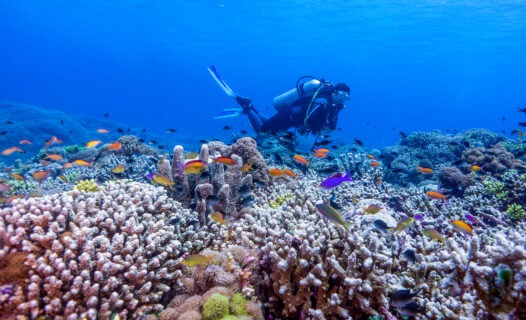
Diving in the Philippines: A Guide to the Best Spots, Best Times to Visit, and Essential Tips
Diving ranks high on the extensive list of reasons to Love the Philippines, and for many good reasons. The country is a diver’s paradise, with its thousands of islands surrounded by some of the most biodiverse marine ecosystems in the world. Get started on your underwater adventure with this Philippines diving guide!
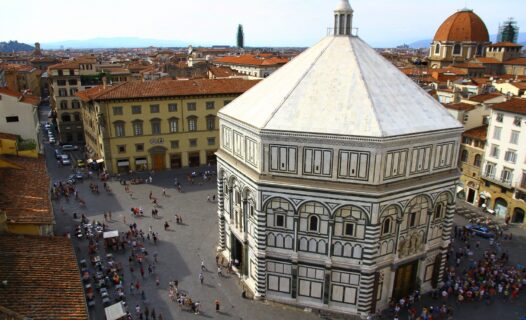
Discover 10 Fun Things to Do in Florence Beyond the Tourist Trail
Discover 10 unforgettable experiences in Florence beyond the tourist trail. Uncover hidden gems and local favorites—start your adventure today!
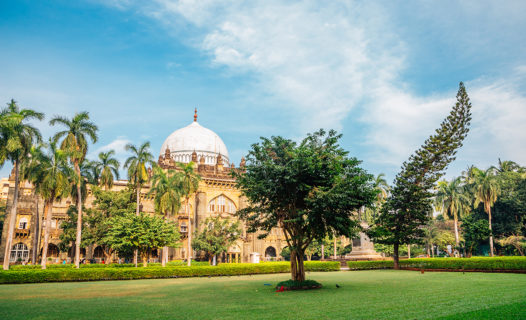
Discover 10 Fun Places to Visit in Mumbai with Friends
Discover the ultimate Mumbai adventure! Explore 10 fun-filled places to visit in Mumbai with friends and create unforgettable memories. Start your journey now!

Chill Out in Goa: Explore the Best Snow Park Experience
Discover the ultimate snow park experience in Goa! From thrilling rides to family fun, explore our guide and plan your perfect chill-out day.
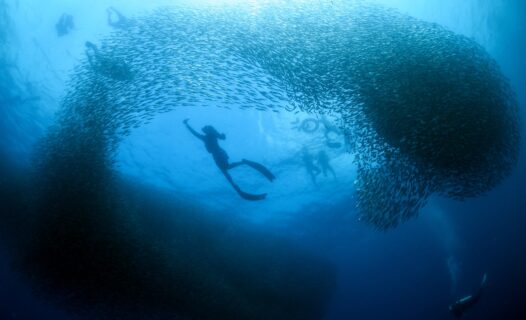
Discover Where Sinulog Festival is Celebrated in Cebu!
Discover where the Sinulog Festival is celebrated in Cebu, Philippines! Join the vibrant festivities and immerse yourself in this unforgettable cultural experience.

Discover Hanoi's Military History Museum: Fun & Adventure!
Discover the captivating tales at Hanoi's Military History Museum! Dive into a fun day of learning and adventure—plan your visit now!

Capture Lory Park Zoo Photos: Your Ultimate Johannesburg Guide
Capture unforgettable moments at Lory Park Zoo! Discover tips for stunning lory park zoo photos and make your Johannesburg adventure memorable. Click to learn more!

Discover Mumbai's Famous Places: Top 10 Epic Adventures
Discover Mumbai's famous places that promise an epic adventure! Explore our top 10 must-visit spots and start planning your unforgettable journey today!
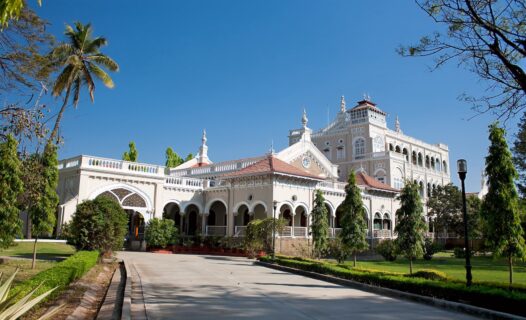
The Aryavart Escape: Snap Stunning Panshet Photos in Pune
Discover the Aryavart Escape and capture stunning Panshet photos on your Pune getaway! Dive into our guide for tips and breathtaking spots. Start your adventure now!

Explore Hanoi's Train Street: Coffee & Scenic Journeys
Discover the charm of Hanoi's Train Street! Join us for a day of thrilling train sightings and delightful coffee sips. Click to explore this unique experience!

Swim with Sharks at Dubai Aquarium: An Unforgettable Adventure
Dive into adventure at the Dubai Aquarium! Discover the thrill of swimming with sharks and make unforgettable memories. Plan your visit today!
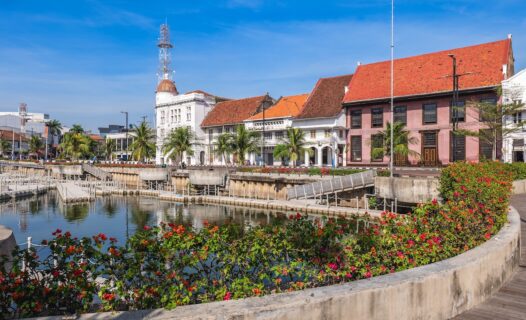
Central Jakarta: Discover Street Eats & Hidden Cafés
Discover Central Jakarta's vibrant food scene! Dive into street eats and hidden cafés that will tantalize your taste buds. Start your culinary adventure now!

Discover 10 Quirky Bangkok Things to Do That Will Make You Smile
Discover Bangkok's quirky side with 10 unusual things to do that will make you smile. Dive into the fun—explore now for a unique adventure!

Kolkata to Digha Train: Your Ultimate Beach Adventure Guide
Embark on a thrilling train journey from Kolkata to Digha! Discover beach bliss and adventure. Read more to plan your perfect getaway today!

Experience Hatyai's Floating Market: A Delicious Adventure
Explore the vibrant floating market in Hatyai! Savor local delicacies and experience unique culture. Dive into delicious adventures today!

10 Notre-Dame Basilica Reviews That Will Captivate You
Discover the magic of Montreal through 10 must-read Notre-Dame Basilica reviews that will captivate your heart. Dive in and fall in love today!

Discover 10 Instagrammable Places to Visit in Islamabad
Discover the top 10 Instagrammable spots in Islamabad that you can't miss! Explore stunning views and vibrant culture—plan your visit to these must-see places now!

Discover 10 Unforgettable Places to Visit in Hinjewadi
Discover the top 10 must-visit spots in Hinjewadi, Pune for an unforgettable adventure! Explore hidden gems and plan your perfect trip today!

Experience Kyoto Tower: Breathtaking Views & Local Flavors
Discover Kyoto Tower's breathtaking views and local delights! Elevate your adventure—explore tips and must-sees in our ultimate guide. Click to learn more!
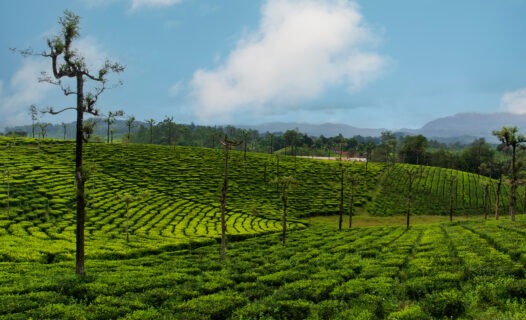
One Day Trip in Coimbatore: Explore Culture, Cuisine & Nature
Experience a whirlwind of culture, cuisine, and nature on your one day trip in Coimbatore! Discover must-visit spots and local delights. Plan your adventure now!
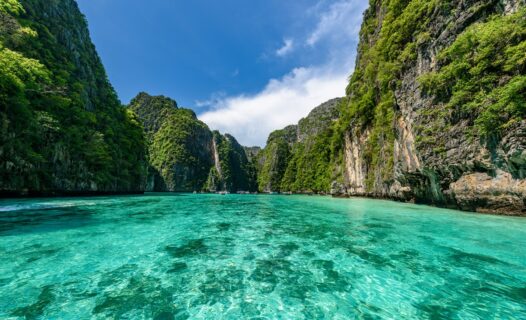
Discover Phuket Beaches: Your Ultimate Beach Hopping Guide
Discover the best Phuket beaches for an unforgettable beach hopping adventure. Dive into sun-soaked fun and plan your perfect getaway today!
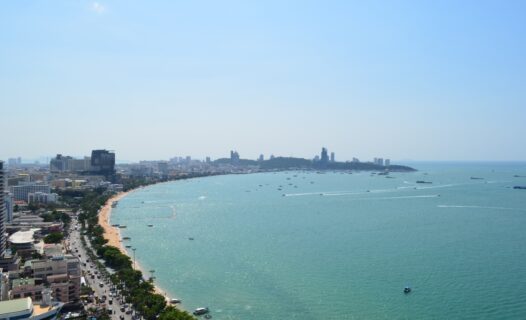
Explore Buddha Temples in Pattaya: A Day of Serenity and Fun
Uncover tranquility at Pattaya's stunning Buddha temples! Explore serene landscapes and vibrant culture in a day of fun. Start your adventure now!



